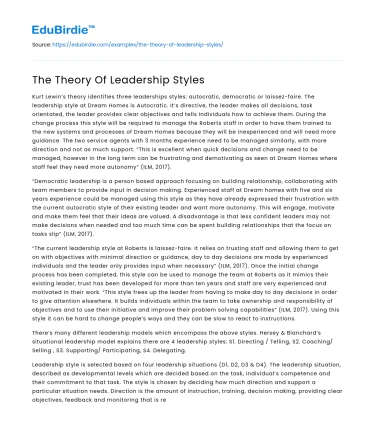Introduction
The theory of leadership styles has been a focal point of organizational studies for decades, representing a critical lens through which we understand leadership effectiveness. Leadership styles refer to the manner and approach of providing direction, implementing plans, and motivating people. This theory posits that different situations call for different leadership styles, and a leader's success is often determined by their ability to adapt. From autocratic to transformational leadership, each style presents unique advantages and challenges. The significance of leadership styles is underscored by their impact on employee motivation, organizational culture, and overall productivity. As organizations grapple with rapid changes in a globalized environment, understanding and applying the appropriate leadership style is more crucial than ever. This essay will delve into various leadership styles, examining their characteristics, strengths, and weaknesses while considering real-world examples and addressing potential counter-arguments.
Autocratic and Democratic Leadership Styles
The autocratic leadership style is characterized by individual control over all decisions, with little input from group members. Leaders make choices based on their ideas and judgments, essentially functioning as the central authority. This style, while efficient in decision-making, can lead to a lack of creativity and employee dissatisfaction. An example of autocratic leadership can be seen in the military, where commands must be followed without question for the sake of discipline and efficiency. However, this approach may not foster innovation or employee engagement, as noted by Lewin et al. (1939) in their seminal study on leadership styles.
Save your time!
We can take care of your essay
- Proper editing and formatting
- Free revision, title page, and bibliography
- Flexible prices and money-back guarantee
In contrast, democratic leadership, also known as participative leadership, involves team members in the decision-making process. This style encourages open communication and considers employee input, which can enhance satisfaction and morale. A prominent example is Google's leadership approach, where employees are encouraged to voice their ideas, leading to innovative solutions and a positive workplace culture. While democratic leadership fosters inclusivity and motivation, it can also slow down decision-making processes and may not be suitable in crisis situations where quick decisions are necessary. These contrasting styles illustrate the importance of context in determining the most effective leadership approach.
Transitioning from the examination of autocratic and democratic styles, it's crucial to consider the impact of transformational and transactional leadership styles, which offer a different perspective on leadership efficacy.
Transformational and Transactional Leadership
Transformational leadership is a style that inspires and motivates employees to exceed expectations by transforming their attitudes and beliefs. Leaders who adopt this style focus on the development and growth of their team members, often encouraging innovation and change. An exemplary figure of transformational leadership is Nelson Mandela, whose vision and charisma galvanized a nation towards social change and reconciliation. According to Burns (1978), transformational leaders align the objectives of followers with the interests of the organization, leading to higher levels of performance and satisfaction.
Transactional leadership, by contrast, is based on a system of rewards and punishments. This style is rooted in a clear structure where leaders set predetermined goals, and employees are rewarded for meeting them. While this can be effective in achieving short-term objectives, it may not foster long-term employee engagement or innovation. A notable example is Henry Ford's leadership at the Ford Motor Company, where efficiency and productivity were achieved through strict adherence to processes and performance-based rewards. Transactional leadership can be highly effective in stable environments but might falter in dynamic settings requiring adaptability and creativity.
Transitioning to the final section, it's essential to explore the situational leadership model, which argues for a more adaptive approach, combining elements from various styles based on specific circumstances.
Situational Leadership and Adaptive Strategies
The situational leadership model, developed by Hersey and Blanchard, posits that there is no single "best" style of leadership. Instead, effective leaders adapt their style to the competence and commitment levels of their followers, as well as the specific task at hand. This approach combines elements of autocratic, democratic, transformational, and transactional styles, tailoring leadership strategies to meet the needs of different situations. For instance, a leader might adopt a more directive style in a high-stakes project but shift to a supportive role when fostering team development.
Real-world applications of situational leadership can be seen in the tech industry, where leaders often need to balance innovation with process control. Companies like Apple have thrived under leaders who adapt their approach based on the evolving market landscape and team dynamics. This versatility is crucial in today’s fast-paced business environment, where change is constant and unpredictable.
However, critics of situational leadership argue that it requires a high degree of emotional intelligence and flexibility, which not all leaders possess. Additionally, frequent changes in leadership style may confuse employees and disrupt team cohesion. Despite these challenges, situational leadership remains a valuable framework for leaders striving to navigate complex organizational landscapes.
Conclusion
In conclusion, the theory of leadership styles provides a comprehensive framework for understanding how leaders can effectively guide their teams and organizations. By examining autocratic, democratic, transformational, transactional, and situational leadership styles, we recognize that each has its merits and limitations, contingent upon the context in which they are applied. Effective leadership requires not only the ability to adopt the appropriate style but also the agility to transition between styles as circumstances evolve. As organizations continue to operate in an increasingly complex and dynamic global environment, leaders must harness a diverse array of strategies to inspire, motivate, and achieve organizational goals. Ultimately, the most successful leaders are those who can blend elements from various styles, tailoring their approach to meet the unique demands of their followers and the challenges they face.






 Stuck on your essay?
Stuck on your essay?

